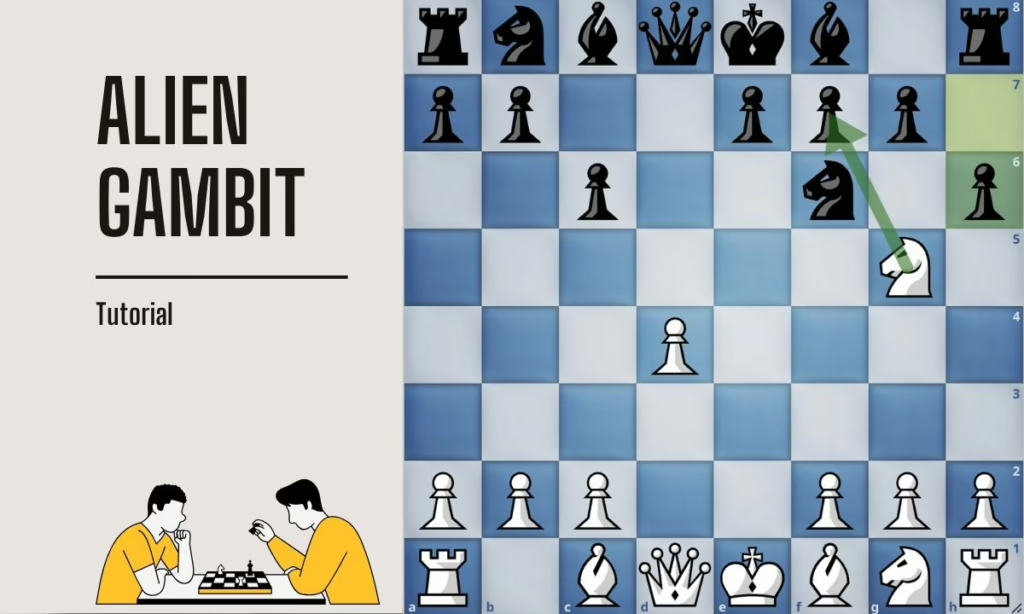Roughly 100,000 games have been played using the Alien Gambit just in January 2024. Many Grandmasters are falling victim to it. Why has it become a hot trend in chess?
Contents
The Alien Gambit is like a new trend in online chess. It’s become super popular, with more than 100,000 games played just in January 2024. People of all skill levels are trying it out, from newbies to masters, including top ones like Hikaru Nakamura. As more and more people get into it, the Alien Gambit could become a regular part of the game for those who like to take risks.
The Alien Gambit, made famous by CM Volen Dyulgerov, aka The Witty Alien, is a bold and unusual opening. Witty Alien is a crazy chess streamer too and you should check out his Youtube channel. The Gambit happens in the Caro-Kann Defense, where White sacrifices a knight on the f7 square to tempt Black’s king into the middle of the board.
Some people might say this gambit isn’t very reliable and isn’t something serious players should try. But in quick games like bullet or blitz, where opponents might not be familiar with it, it can create confusion and lead to big mistakes. Even experienced players like Eric Rosen can struggle with it, dealing with weird piece positions and the challenge of not being able to castle.

The Alien Gambit Theory
First of all, let’s review the game between two FIDE Masters below, which took place just a few weeks ago. It’s an online bullet game on Lichess. The Russian FM Gor Glidzhian, playing as White, employed the Alien Gambit.
As you can see, Glidzhian sacrificed a knight to weaken Black’s kingside, then launched a deadly attack on the king, winning the game in just 20 moves. White’s subsequent moves after 6.Nxf7 were straightforward and clear. These included moves like Nf3, Bd3 (or Bc4), Ne5 (or Ng5), Qf3 (or Qh5), 0-0, and Re1. White could even sacrifice the bishop on h6 pawn at some point, using the other bishop to attack Black’s weak light squares and the b1-h7 diagonal. White can also target the weak e6 pawn or maneuver the rook from e1 to e3 and g3 for a kingside attack. There were numerous ways for White to mount an attack, while Black had limited defensive options.
Now I will go into more detail about the theory behind the Alien Gambit, based on a game where the 2600 Elo rated Grandmaster Miguel Santos Ruiz was defeated in a bullet game.
Here is another example where the player executed the gambit very effectively, winning the game in just 18 moves.
Most common responses for Black in the 7th move
Let’s look at the table below.
| Move | % of moves | White won | Black won |
| Nbd7 | 24% | 56% | 40% |
| e6 | 20% | 58% | 39% |
| Bg4 | 19% | 84% | 15% |
| Bf5 | 11% | 54% | 43% |
| Be6 | 7% | 55% | 41% |
| Kg8 | 6% | 56% | 41% |
| g6 | 4% | 56% | 41% |
| g5 | 3% | 62% | 36% |
| Ke8 | 2% | 68% | 30% |
| c5 | 1% | 39% | 57% |
The table shows the 10th most common responses for Black after White’s 7.Nf3. Surprisingly, the best move for Black is the 10th choice, which is 7…c5. Black has a 57% chance of winning after this move. The other moves would leave Black with just a 43% or less chance of winning. That’s why the Alien Gambit is so popular right now. Because, it gives White so many chances to win.
Why did 7…Bg4 give White 84% of winning? Because White can launch a knight fork.
A Trap when Black plays 7… Bf5
Strategies for Tackling the Alien Gambit
A 2100-rated chess player was winning against Hikaru Nakamura when the top grandmaster played the Alien Gambit a few weeks ago. How could that be possible? Well, the lower-rated player used 7…c5, then traded the Queen. He lost, obviously, but put up a good fight. That’s the best way to counter the Alien Gambit, as shown in the table above.
Over time, as more people get used to it, the Alien Gambit might lose some of its surprise factor. Still, its ability to disrupt opponents and create chaos on the board shouldn’t be underestimated. While it’s not recommended for longer games or playing without practice, the Alien Gambit adds excitement and creativity to the game.
The Alien Gambit might seem reckless, but it mirrors the fearless style of legendary players who thrived on chaos, like Mikhail Tal. Tal, known as “The Magician from Riga,” turned chess into a battlefield where his opponents were constantly under attack. Just as the Alien Gambit lures Black’s king into dangerous square with 6.Nxf7, Tal’s games were a masterclass in sacrifices, positional destruction, and relentless attacking.
Practical Play: Tips for Wielding and Defeating the Alien Gambit
Theory provides the foundation, but success in fast-paced online chess comes down to practical execution. This section offers concise, actionable tips for players on both sides of this volatile opening.
For White: Maximizing the Chaos
• Focus on Speed: Your primary asset is the initiative. Prioritize rapid development of your pieces toward the Black king. Every tempo counts, and maintaining pressure is more important than material.
• Know Your Patterns: Memorize the key attacking ideas. Be ready to play moves like Ne5, Qf3, and execute maneuvers like the Re1-e3-g3 rook lift without hesitation.
• Play for Tricks: The position is inherently tactical. Constantly look for forks, pins, and sacrifices that complicate the position and force your opponent to solve difficult problems under time pressure.
For Black: Neutralizing the Attack
• Don’t Panic: The most important first step is to remain calm. Accept the sacrificed piece and trust that your material advantage is a long-term winning factor if you can consolidate.
• Prioritize King Safety: Your king is vulnerable. Move it away from the center as quickly as possible (to g8 or e8) and coordinate your pieces to defend critical squares.
• Seek Queen Trades: This is the silver bullet against White’s attack. Trading queens almost always defuses the pressure and simplifies the position into a winning endgame for Black.
• Remember 7…c5!: Burn this move into your memory. It is the golden response that challenges White’s plan at its root and sets you on the correct path to victory.
The 2025 Verdict: Is the Alien Gambit Still a Viable Weapon?
While the Alien Gambit was the sensation of early 2024, its long-term viability depends on how the chess community has adapted. A year later, we can offer a more measured assessment of its strength, popularity, and place in the modern game.
Its initial shock value has certainly diminished. As more players have encountered the gambit and learned its primary refutations—namely, the 7...c5 defense and the queen-trading strategy. Its effectiveness against prepared opponents has decreased. However, it remains a popular surprise weapon in online chess pools, especially at the intermediate levels where theoretical knowledge may be less developed.
Theoretically, its reputation as “unsound” has solidified. Top-level analysis confirms that with correct play, Black should win. Yet, there remains a critical distinction between theoretical soundness and practical effectiveness, particularly in the rapid-fire environment of online blitz and bullet chess.
The gambit’s primary strength in 2025 is not its objective power but its profound psychological impact. It immediately forces opponents out of their comfort zones and into a chaotic, tactical battle. Under the pressure of the clock, even strong players can fail to find the precise defensive moves required, making the Alien Gambit a potent tool for inducing errors.
To get a truly objective view, however, we must turn to the ultimate arbiters of chess theory: modern engines.
Frequently Asked Questions (FAQ) – Updated for 2025
Q: What is the Alien Gambit?
The Alien Gambit is an aggressive opening in the Caro-Kann Defense where White sacrifices a knight on f7 to lure Black’s king into the center. It was popularized by CM Volen Dyulgerov, also known as The Witty Alien.
Q: Is the Alien Gambit a theoretically sound opening? No, it is considered unsound in classical chess. With precise defense, Black can refute the attack and convert a material advantage. However, it remains a dangerous practical weapon in faster time controls like blitz and bullet.
Q: Who invented the Alien Gambit? The opening was popularized by Bulgarian Candidate Master Volen Dyulgerov, who streams under the name “The Witty Alien.” He introduced and showcased it extensively in his online play.
Q: Why did the Alien Gambit become so popular? Its popularity surged due to its surprise value, immense attacking potential, and viral spread on streaming platforms like Twitch and YouTube. Many players are drawn to its chaotic and aggressive style.
Q: How do you best refute the Alien Gambit? The most effective refutation for Black begins with the move 7...c5. This move challenges White’s center and allows Black to develop pieces effectively. The overarching strategy is to neutralize White’s attack by trading queens, leading to a much safer, and often winning, position.
Q: Are there other major traps for Black? Yes. While 7...Bg4 is the most common and catastrophic blunder, the move 7...Bf5 is also a significant mistake. Though not as immediately disastrous as 7...Bg4, it allows White to maintain a strong initiative. The best refutation remains the principled 7...c5.
Q: Can you decline the Alien Gambit? Yes, declining the gambit is an option. However, the vast majority of analysis and play focuses on accepting the sacrifice with 6...Kxf7 and proving the gambit is unsound, which is the most ambitious and promising approach for Black.
Q: Do Grandmasters play the Alien Gambit in 2025? Grandmasters occasionally play it in casual online blitz or bullet games for entertainment, but it is not used in serious, classical tournament games due to its theoretical flaws.
Q: Is the Alien Gambit good for beginners?
It can be fun for beginners who want to learn attacking patterns. But for long-term improvement, it’s better to focus on sounder openings and use the Alien Gambit as a surprise weapon in casual or fast games.

I’m Xuan Binh, the founder of Attacking Chess, and the Deputy Head of Communications at the Vietnam Chess Federation (VCF). My chess.com and lichess rating is above 2300. Send me a challenge or message via Lichess. Follow me on Twitter (X) or Facebook.


3 thoughts on “Alien Gambit: The Hottest Trend in Chess (Updated 2025)”
Comments are closed.